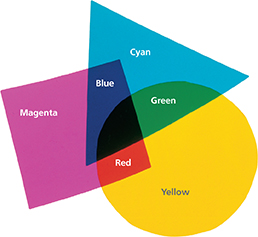Mixing Pigments
Paints, inks, photographs, and dyes get their colors from pigments. A pigment is a material that absorbs some colors of light and reflects other colors. Stone Age cave paintings were made with natural pigments from colored earth and clay. Over the centuries, natural pigments have been obtained from many sources, including metal oxide compounds, minerals, plants, and animals. Today's artists use paints made from natural pigments as well as from synthetic, or manufactured, pigments.
 The primary colors of pigments are cyan, yellow, and magenta. Perhaps you have noticed that color printers and photocopiers use these three colors, plus black. You can mix varying amounts of these primary pigment colors to make almost any other color. Each pigment reflects one or more colors. As pigments are mixed together, more colors are absorbed and fewer colors are reflected. When two or more pigments are mixed together, the colors absorbed by each pigment are subtracted out of the light that strikes the mixture.
The primary colors of pigments are cyan, yellow, and magenta. Perhaps you have noticed that color printers and photocopiers use these three colors, plus black. You can mix varying amounts of these primary pigment colors to make almost any other color. Each pigment reflects one or more colors. As pigments are mixed together, more colors are absorbed and fewer colors are reflected. When two or more pigments are mixed together, the colors absorbed by each pigment are subtracted out of the light that strikes the mixture.
Look at Figure 26. The light filters absorb light in much the same way pigments do. When cyan and magenta are combined, blue is formed. Cyan and yellow combine to form green. Yellow and magenta combine to form red. The secondary colors of pigments are red, green, and blue. Any two colors of pigments that combine to make black pigment are complementary colors of pigments.
Figure 26 The three primary colors of pigments are cyan, yellow, and magenta. When the three primary colors of pigments are combined, the secondary colors of pigments are formed. Interpreting Diagrams Which colors of pigments combine to make black?

Section 18.4 Assessment
Reviewing Concepts
 Explain how a prism separates white light into the colors of the spectrum.
Explain how a prism separates white light into the colors of the spectrum. What determines the color of an object?
What determines the color of an object? What three colors of light can combine to form any other color?
What three colors of light can combine to form any other color? What three colors of pigments can combine to form any other color?
What three colors of pigments can combine to form any other color?Explain how the process of dispersion of light forms a rainbow.
What are pigments? Explain how different pigments affect light.
Critical Thinking
Predicting What color would a blue wall appear under green light?
Applying Concepts Why does combining equal amounts of cyan, yellow, and magenta paints form black?
Writing in Science
Explain a Concept Write a letter to a friend who is not in class with you. Explain how an object gets its color. Give evidence and use examples to support your explanation.




